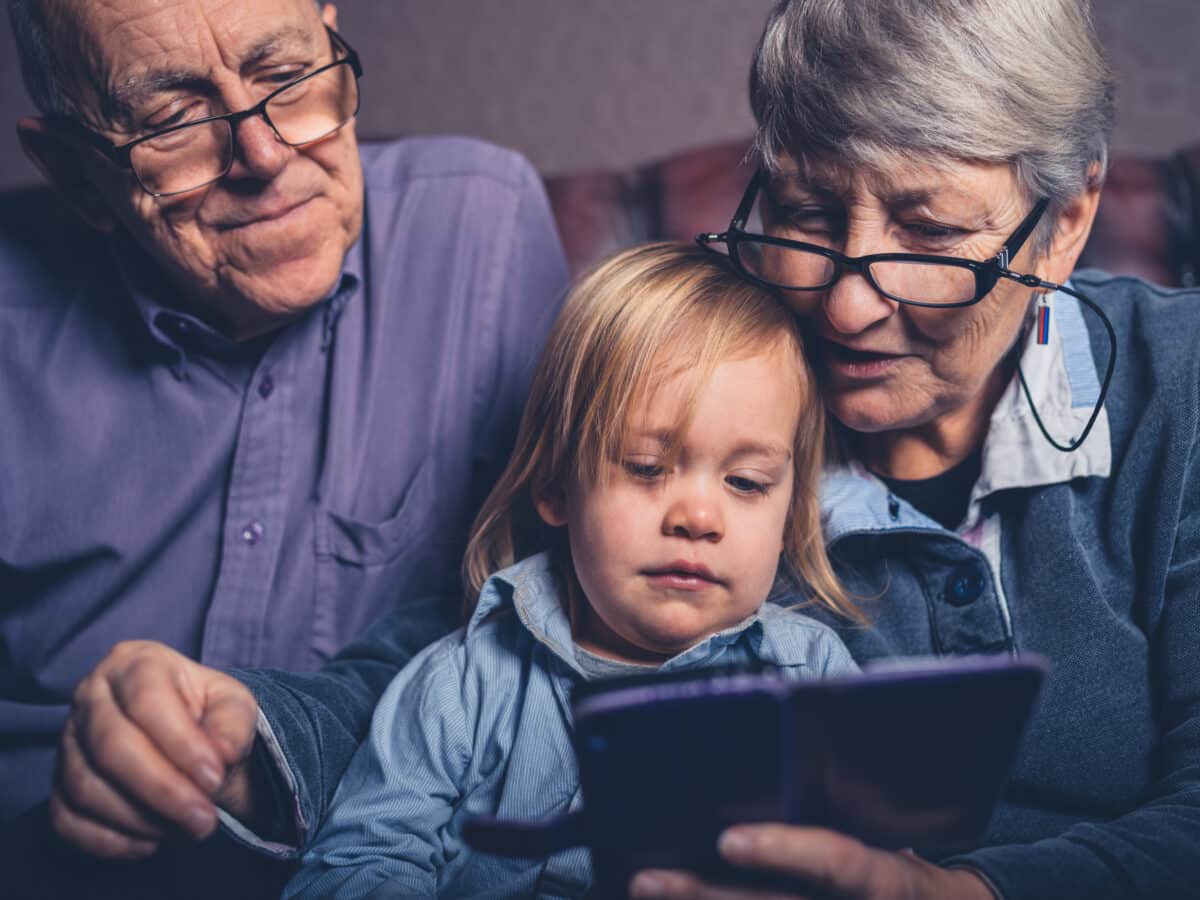
(© fizkes - stock.adobe.com)
In a nutshell
- Children spend 49% of their time with grandparents using screens, with traditional TV watching being the most common activity at 20% of their time.
- Grandparents with better digital skills are more effective at managing their grandchildren’s media use across all strategies, highlighting the need for tech education for older caregivers.
- Negative attitudes about media lead to disagreements between grandparents and parents, which directly harm family relationships and satisfaction.
TUCSON, Ariz. — When grandma and grandpa take over childcare duties, nearly half the time is spent staring at screens, according to new research that reveals a growing generational digital gap with real family consequences.
A study published this month found that American children spend 49% of their waking hours with grandparents engaged with digital media—from watching TV to playing video games and scrolling through apps.
This screen-heavy reality creates friction between generations, with one-third of American parents reporting disagreements with grandparents over their children’s media use. These conflicts can damage important family relationships, researchers found.
“With grandparents now playing such an essential role in shaping the lives of their grandchildren, important questions relate to how they are adjusting to their expanded role as caregivers,” write researchers Cecilia Sada Garibay and Matthew A. Lapierre from the University of Arizona in their Journal of Children and Media paper.
The Digital Babysitting Reality
Today’s grandparents face parenting challenges their generation never encountered. Economic pressures, higher divorce rates, and more working mothers have thrust many into regular childcare roles without preparation for managing digital natives.
The researchers surveyed 350 American grandparents who regularly watch at least one grandchild between ages 2 and 10. The breakdown of screen time showed traditional TV watching consumed 20% of shared time, while another 12% went to viewing videos on mobile devices. Video games filled 9% of time, and internet browsing or app use took up 8%.
Many grandparents feel ill-equipped in this digital landscape. “Literature shows that older people tend to be less skilled with digital technology than younger ones,” the researchers note.

How Grandparents Manage Screen Time
The study identified four main strategies grandparents use to manage their grandchildren’s media consumption: supervision (simply keeping an eye on what kids watch), restrictive mediation (setting firm rules), instructive mediation (discussing content), and co-viewing (watching together).
Supervision emerged as their go-to approach, while co-viewing—which research suggests might be the most beneficial strategy—was the least common. This preference likely stems from two factors: supervision requires less technical knowledge, and many grandparents feel uncertain about overstepping parental boundaries.
“For many grandparents, applying restrictive and instructive mediation is delicate as they consider that setting rules and teaching children about media content are mainly parents’ responsibilities,” the researchers explained
Digital skill level emerged as the strongest predictor of effective screen management. Grandparents with higher digital competence consistently applied better mediation across all approaches. Age and gender also played roles—younger grandparents were more likely to co-view content, while grandfathers applied less supervision than grandmothers.
Family Tensions Over Technology
The study revealed that attitudes about media affected family dynamics. Grandparents worried about technology’s effects often disagreed with parents about appropriate screen time, and these conflicts directly correlated with lower satisfaction in their relationships.
“Grandparents’ beliefs that their grandchildren have excessive screen time or that they use media in undesired situations are a source of disagreement between them and their adult children, particularly when grandparents have a negative evaluation of media,” the researchers explain.
Without support, this digital divide threatens both effective screen management for children and healthy family connections. As grandparents continue taking on essential childcare roles, helping them navigate the digital landscape becomes increasingly urgent.
Paper Summary
Methodology
The study surveyed 350 American grandparents (178 male, 172 female) with an average age of 55.6 years who regularly care for at least one grandchild between ages 2-10. To qualify, participants needed to care for their grandchild at least three times monthly and not be the primary caregiver. Researchers collected data on children’s media use during grandparental care, the strategies grandparents use to manage media consumption, grandparents’ digital skills, their attitudes toward media, and their relationship satisfaction with their adult children. The survey utilized established measurement scales for grandparental mediation practices, digital skills assessment, beliefs about media effects, and relationship satisfaction.
Results
The study found that children spent 49% of their time with grandparents engaged with media (20% watching traditional TV, 12% watching on other devices, 9% playing video games, and 8% using internet/apps). Regarding mediation strategies, grandparents favored supervision (staying near the child) over more active approaches, with co-viewing being the least used strategy. Digital skills emerged as the only variable that consistently predicted higher levels of all mediation strategies. Younger grandparents applied more instructive mediation and co-viewing, while grandfathers were less likely to use supervision than grandmothers. The research also revealed that grandparents’ negative attitudes toward media predicted disagreements with their adult children about children’s media use, and these disagreements were associated with lower relationship satisfaction.
Limitations
The study has several limitations. The online recruitment method likely excluded grandparents with limited digital skills, and the sample was predominantly White (90.9%), lacking diversity across racial and ethnic backgrounds. As a cross-sectional study, it cannot establish causality between variables. The researchers didn’t inquire about caregiving conditions (whether grandparents cared for children alone or with others, or in whose home). Media use measurement used predefined time intervals rather than exact minutes, limiting precision. Some scales, particularly for positive media beliefs, showed low reliability, suggesting a need for developing more reliable measurements specific to grandparents’ perspectives.
Funding and Disclosures
The study was funded by a small faculty grant awarded to Matthew A. Lapierre through the Social & Behavioral Sciences Research Institute at the University of Arizona (award #: 22FSF01247). The authors reported no potential conflicts of interest.
Publication Information
The paper titled “Grandparents and children’s media use in the USA: Screen time, mediation practices, and relationship outcomes” was authored by Cecilia Sada Garibay (Universidad Panamericana, Mexico City, Mexico and University of Arizona) and Matthew A. Lapierre (University of Arizona). It was published in the Journal of Children and Media on April 6, 2025, and is available online at https://doi.org/10.1080/17482798.2025.2480088.







